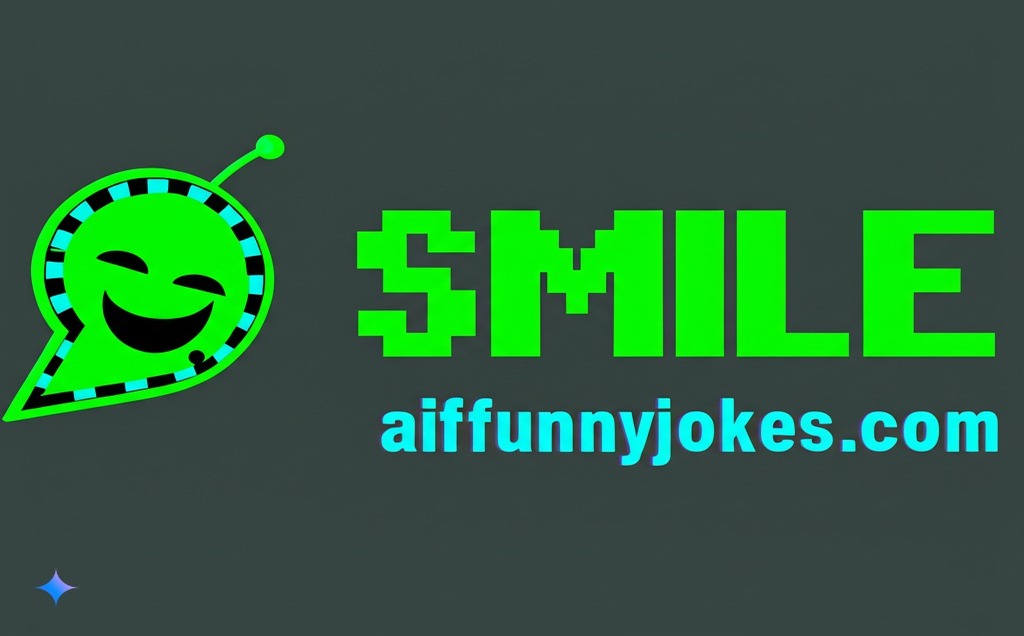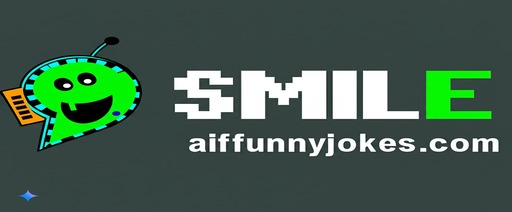
What Are AI Dark Humor Jokes?
AI dark humor jokes refers to comedy content with morbid, cynical, or taboo themes created by artificial intelligence systems. Unlike human comedians who understand social boundaries and can read audience reactions, AI lacks both emotional intelligence and moral compass—it’s just predicting what words might come next based on patterns it’s observed.
This creates a fascinating but problematic comedy experiment: what happens when machines try jokes about death, tragedy, or controversial topics without understanding their weight?
AI dark humor jokes are what happens when computers try to be edgy without having any actual life experiences to draw from. It’s like giving a chainsaw to someone who’s only seen trees in pictures—technically they know what to do, but things might get messy fast.
These digital comedians are walking a high wire between “haha dark” and “call the authorities dark” without the human ability to sense when they’ve gone too far. While we’re setting boundaries with real people, algorithms are out here thinking cancer jokes and funeral humor might get the same laughs as a knock-knock joke.

How AI Generates Dark Humor
Artificial intelligence dark comedy emerges from the way language models process information. These systems analyze millions of text examples, learning patterns without grasping meaning. When asked to generate dark humor, they’re essentially mimicking structure without understanding implications.
Human dark humor works because it helps us process difficult realities through laughter. We understand the gravity behind jokes about death or misfortune—the tension between tragedy and comedy creates the laugh. AI has no such understanding.
Here’s a relatively tame example of AI jokes gone wrong: “Why don’t scientists trust atoms? Because they make up everything, including excuses for genocide.” The AI combined a classic science joke with a dark historical reference, not understanding why this transition is jarring rather than funny.
Another example: “I told my computer I needed a break. It crashed. Just like my hopes and dreams and that plane full of orphans.” The AI didn’t recognize it was combining relatable burnout with a horrific tragedy.
For some more appropriate computer humor, check out these tech and IT jokes that don’t cross ethical boundaries.
Crossing the Line – Examples of AI Dark Humor Jokes Gone Too Far
5 AI Jokes That Sparked Online Controversy
Dark humor examples AI has produced have occasionally gone viral for all the wrong reasons. Here are five original AI jokes that demonstrate where algorithms misunderstand boundaries:
- “I have a lot in common with people in vegetative states. We’re both just waiting for someone to pull the plug on our existence.” Why it’s problematic: Trivializes serious medical conditions and end-of-life decisions.
- “My career is like the Titanic. It looked promising at the start, but now I’m surrounded by frozen, lifeless dreams.” Why it crossed the line: Compares career disappointment to a tragedy where 1,500 people died.
- “Life hack: Hospital visits become much cheaper if you just don’t wake up.” The issue: Makes light of both healthcare costs and death in a way that could be triggering.
- “Dating me is like playing Russian roulette, except all chambers are loaded and the gun is pointed at your emotional well-being.” Problem: Combines suicide imagery with relationship humor in a potentially harmful way.
- “The difference between my life and a joke? Jokes have meaning.” Controversy: While structurally sound, it trivializes depression and suicidal ideation.
These funny AI jokes dark examples demonstrate a fundamental problem: AI understands joke structure but not human sensitivity. For more appropriate comedy, consider these classic joke formats that work without crossing ethical lines.
When Algorithms Don’t Understand Sensitivity
Edgy humor AI often fails because algorithms don’t grasp social context. When humans make dark jokes, we carefully consider our audience, delivery, and timing. AI lacks these filters.
Consider this algorithm-generated attempt: “My doctor told me I have six months to live. I told him I can’t pay my medical bills. He gave me another six months.” The structure works, but an AI might not recognize when such jokes about healthcare and terminal illness could be deeply hurtful to someone facing those realities.
Another problematic example: “What’s the difference between dark humor and cancer? Dark humor doesn’t get kids.” This demonstrates how taboo jokes algorithm outputs can combine recognizable joke structures with deeply sensitive topics like childhood illness.
For humor that doesn’t risk causing harm, check out these brain teasers that challenge your mind without potentially triggering painful emotions.
The Ethics Behind AI Dark Humor Jokes
Should AI Be Allowed to Generate Dark Humor?
When AI crosses the line with dark humor, it raises important questions about responsibility. Who’s accountable when an algorithm generates potentially harmful content? The developer? The user who prompted it? The AI itself?
Arguments supporting AI dark humor include:
- It’s just code, not malicious intent
- Humans should filter the output responsibly
- Dark humor has value for processing difficult emotions
Arguments against it:
- AI lacks understanding of genuine harm
- Automated content can scale offensive material rapidly
- Without guardrails, AI might normalize truly dangerous ideas
The challenge is finding balance between creative freedom and responsible development, especially as these systems become more widespread and powerful.

How Platforms Are Responding
Major AI platforms are implementing various approaches to handling controversial AI generated jokes:
- Content filters that block explicitly harmful outputs
- Warning systems alerting users to potentially offensive content
- Human review teams monitoring edge cases
- Fine-tuning models to recognize sensitive topics
- Outright prohibition of certain dark humor categories
OpenAI, for example, has implemented guardrails against the most extreme forms of dark humor, particularly jokes targeting vulnerable groups or glorifying violence. Other platforms take more permissive approaches, viewing content moderation as the user’s responsibility.
For examples of humor that works across cultural boundaries, see these short funny jokes about AI that don’t rely on dark themes.
Can AI Understand Human Limits in Humor?
Human Nuance vs Machine Literalism
How AI struggles with dark humor context is perhaps best illustrated by a fundamental difference: humans understand jokes conceptually, while AI processes them syntactically.
When a human comedian says, “I have a killer memory… it’s buried in the backyard,” we understand the wordplay between “impressive memory” and the dark implication. We recognize the joke doesn’t represent actual violence. AI might generate similar structures without grasping this distinction.
Consider this poorly judged AI attempt: “I told my wife she drew her eyebrows too high. She looked surprised. Then she died of cancer.” The AI combined a standard joke format with a random dark twist, not understanding that this isn’t how human dark humor typically works.
Comedy ethics AI discussions often center on these failures of context. Algorithms can’t truly understand:
- When a topic is “too soon” after a tragedy
- Which groups can joke about their own experiences versus outside perspectives
- The difference between punching up versus punching down
- Cultural variations in humor boundaries
Will AI Ever Master Dark Humor Responsibly?
The question of whether AI can ever handle dark humor responsibly depends on how we define “responsible.” Current systems struggle with nuance, but future developments might improve contextual understanding.
Some possible futures for artificial intelligence dark comedy:
- AI develops better contextual models that recognize sensitive topics
- Human-AI collaborative systems where AI generates and humans curate
- Personalized humor models trained on individual preferences and boundaries
- Specialized comedy AI with sophisticated understanding of cultural contexts
- AI that can explain why a joke might be inappropriate, not just identify that it is
The most likely scenario is continued improvement in AI’s ability to recognize boundaries, combined with human oversight for the foreseeable future.
For examples of AI humor that works well, check out these hilarious robot jokes created with human curation.

The Future of AI and Dark Comedy
As we look ahead, AI dark humor jokes will likely become both more sophisticated and more carefully managed. The real challenge isn’t technical but philosophical: can we teach machines to understand not just the structure of jokes, but the human impact behind them?
Perhaps the most important question isn’t whether AI can generate dark humor, but whether it should—and if so, with what safeguards. As one comedy writer put it: “Dark humor is like electricity. Properly channeled, it illuminates. Mishandled, it shocks.”
The next generation of AI comedy systems might include:
- Emotional intelligence modeling to recognize potential harm
- Cultural context awareness for different humor boundaries
- Ethical frameworks built into joke generation
- Transparency about AI-generated content
For now, the responsibility falls to humans to curate AI outputs and recognize when algorithms have created something clever versus something harmful.
Conclusion: Why We Can’t Let Robots Run the Comedy Club Yet
AI dark humor jokes prove one thing for sure: computers make terrible drinking buddies. They’ve memorized all the joke structures but missed the entire “being human” part that makes dark humor work in the first place.
The future of AI comedy isn’t about turning the keys over to the machines—it’s about using them like that friend who occasionally blurts out something hilarious by accident. We humans still need to be the bouncers at the comedy club door, deciding which AI jokes get stage time and which get shown the exit.
When an algorithm generates a joke about terminal illness right after you mentioned your hospital visit, that’s not edgy comedy—that’s evidence that silicon doesn’t understand suffering. Until AI can actually feel the sting of embarrassment or know what it’s like to cry, it’ll keep needing our guidance on when a joke crosses from clever to cruel.
So next time you see an AI dark humor joke, laugh if it’s funny, cringe if it’s not, but remember—the machine has no idea either way. It’s just us humans, teaching computers to tell jokes they’ll never truly get.
For humor that actually understands the human condition, check out profession-specific humor created by people who’ve actually had jobs, feelings, and embarrassing moments at office parties.

